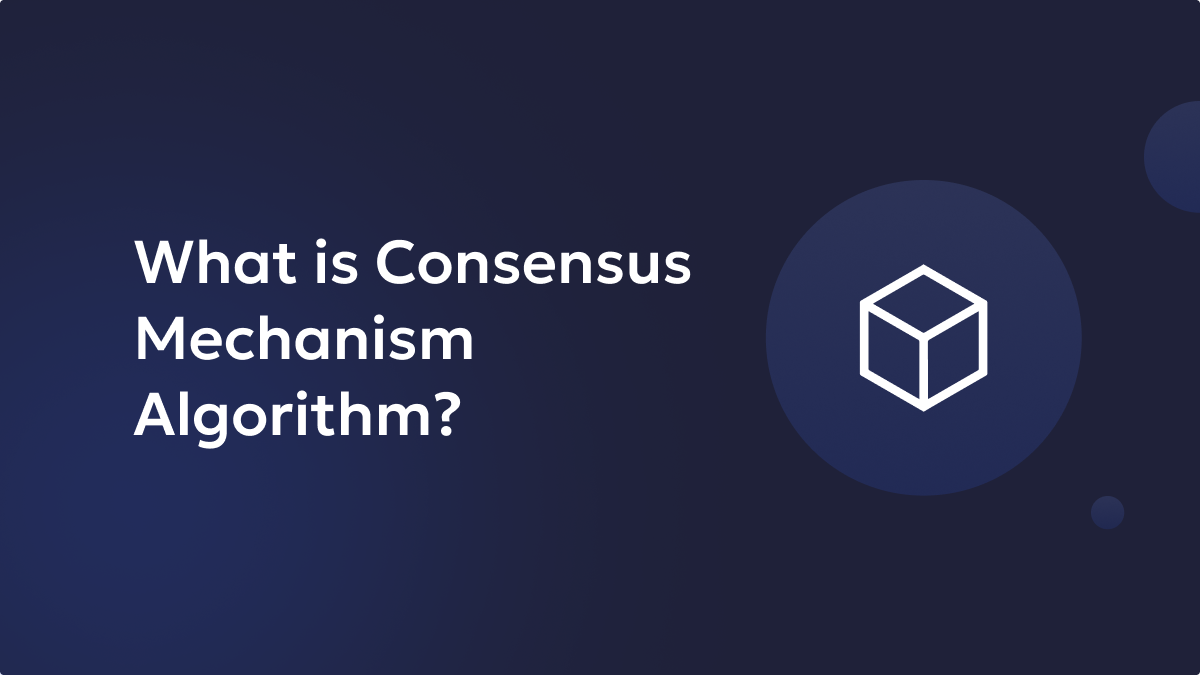Introduction
Consensus mechanisms are essential in blockchain technology for achieving agreement among distributed network nodes. They ensure that every transaction recorded on the blockchain is accurate and validated by the majority of participants, preventing fraud and double spending.
Key Takeaways
Consensus mechanisms ensure the integrity and security of blockchain networks.
Different types of consensus algorithms, such as PoW, PoS, and DPoS, have their unique advantages and disadvantages.
The choice of consensus mechanism impacts the blockchain’s scalability, energy efficiency, and decentralization.
What Is a Consensus Mechanism Algorithm in Blockchain?
A consensus mechanism algorithm in blockchain is a fundamental protocol ensuring all participants in a decentralized network agree on a single version of the truth. It is crucial for maintaining the integrity and security of the blockchain.
How Consensus Mechanisms Algorithm Work
Consensus mechanisms work by having nodes in the network agree on the validity of transactions and the state of the blockchain. This process involves various algorithms and protocols that ensure a decentralized, secure, and tamper-proof ledger.
Types of Consensus Mechanism Algorithms
Proof of Work (PoW)
Proof of Work (PoW)is a consensus mechanism where nodes, known as miners, compete to solve complex mathematical puzzles. The first miner to solve the puzzle gets the right to validate transactions and add a new block to the blockchain. This process requires substantial computational power, ensuring the integrity and security of the blockchain.
Use Case: Bitcoin
Pros:
Security: Highly secure and resistant to various types of attacks, including double-spending.
Decentralization: The competitive nature of mining encourages decentralization.
Cons:
Energy-Intensive: Requires significant energy consumption, leading to environmental concerns.
Slow Transactions: The time required to solve the puzzles results in slower transaction processing times.
Advantages
– Decentralized Structure: Proof of Work (PoW) ensures a broad distribution of operational power across numerous participants. Anyone with the necessary resources and time can become a node operator and mine blocks. This equal distribution of power helps prevent any single group from dominating the blockchain for personal gain. PoW blockchains are inherently resistant to control by a central authority.
– High Security: PoW blockchains offer robust security. Due to the immense computational power required to control more than half of the network, attacks like the 51% attack are virtually unfeasible. Bitcoin, a prominent example of a PoW blockchain, has maintained a strong security track record without being compromised, highlighting the effectiveness of PoW in safeguarding data.
– Adequate Scalability: Scalability is crucial for accommodating a growing number of users efficiently. While many PoW blockchains might not be the most scalable, they have improved with the introduction of scaling solutions, enabling them to serve millions of users at a lower cost and higher speed.
Disadvantages
– Slow Block Creation: PoW blockchains often experience longer block creation times, especially as the difficulty of mining increases. This delay results in slower transaction processing and can lead to a less satisfactory user experience.
– Energy Inefficiency: The PoW consensus mechanism demands significant energy to operate the necessary hardware. For instance, Bitcoin’s annual energy consumption surpasses that of Norway, illustrating the substantial environmental impact. This inefficiency has led some major blockchains, like Ethereum, to transition from PoW to more energy-efficient alternatives like Proof of Stake (PoS).
– Special Hardware Requirements: PoW requires specialized hardware, such as mining machines and sometimes even specific devices like Raspberry Pi. This need for special equipment makes it less accessible compared to other consensus mechanisms, which generally only require a standard PC and storage.
– High Computational Costs: The setup and operation of PoW mining involve high costs. For example, a Bitcoin mining rig can cost over $1,700, and the energy consumption required for mining adds to the operational expenses. These high costs can be a barrier to entry for potential miners.
– Bandwidth Demands: PoW blockchains have significant bandwidth requirements, including:
– Internet speeds of at least 50 Kbps
– Approximately 20 GB of data to download per month
– About 200 GB of data to upload monthly
These requirements can be challenging to meet in certain regions, potentially excluding individuals in those areas from participating in the consensus process.
Proof of Stake (PoS)
Proof of Stake (PoS) selects validators to create new blocks based on the number of coins they hold and are willing to “stake” as collateral. The more coins a validator stakes, the higher their chance of being selected to validate transactions and add blocks to the blockchain.
Use Case: Ethereum 2.0
Pros:
Energy-Efficient: Consumes significantly less energy compared to PoW.
Faster Transactions: Transactions can be processed more quickly due to reduced computational requirements.
Cons:
Wealth Concentration: PoS can favor wealthier participants, as those with more coins have more influence.
Advantages
- Fast Block Creation Time: Proof of Stake (PoS) enables much quicker block creation compared to Proof of Work (PoW). While PoW, as seen in Bitcoin, can take up to 10 minutes to create a block, PoS systems generate new blocks in just seconds, leading to faster transactions.
- High Throughput: The rapid block creation time in PoS allows for the processing of a higher number of transactions quickly, improving overall throughput.
- Energy Efficiency: PoS is significantly more energy-efficient than computationally intensive models like PoW. Research shows that PoS can reduce energy consumption by up to 99% compared to PoW. Validators are chosen based on their staking power rather than solving complex puzzles, conserving energy.
- Scalability: PoS is a scalable consensus mechanism that handles growing transaction volumes effectively without sacrificing speed. However, it is not as scalable as PoW.
- No Special Hardware Required: Becoming a validator in a PoS system does not require specialized hardware. Validators need only basic CPU and storage, along with staking assets, which lowers the barrier to entry and encourages broader participation.
Disadvantages
- Potential for Centralization: PoS can lead to centralization since the ability to become a validator often depends on having substantial native assets to stake. Those with significant holdings can dominate consensus processes, affecting the decentralization of the blockchain.
- Lower Cost of Misbehavior: Some PoS blockchains are relatively inexpensive to set up, which can reduce the financial risk for validators who engage in misconduct. For instance, on Cardano, validators need to stake a minimum of 25,000 ADA, roughly $9,600, which might not be a substantial deterrent against dishonest behavior.
Delegated Proof of Stake (DPoS)
Delegated Proof of Stake (DPoS) allows coin holders to vote for a small number of delegates who are responsible for validating transactions and maintaining the blockchain. This system enhances scalability and speeds up transaction processing.
Use Case: EOS, Tron
Pros:
Speed: Capable of handling a high volume of transactions.
Scalability: The reduced number of validators allows for more scalable solutions.
Cons:
Centralization Risk: With fewer validators, there is a higher risk of centralization.
Advantages
- Scalability: Delegated Proof of Stake (DPoS) enhances scalability by using a limited number of witnesses. This streamlined approach accelerates decision-making and efficiently handles a higher volume of transactions.
- Energy Efficiency: As a variant of Proof of Stake (PoS), DPoS does not require significant computational power. Instead, witnesses are selected based on their stake in the network, making DPoS a more energy-efficient and environmentally friendly option.
- Low-Cost Transactions: Unlike Proof of Work (PoW), which can become congested and require miners to be incentivized with higher fees, DPoS offers a faster and more cost-effective consensus model, reducing transaction costs.
Disadvantages
- Semi-Centralization: A key drawback of DPoS is its tendency toward semi-centralization. The limited number of selected witnesses can create an informal centralized council, which may undermine the decentralized ethos of blockchain and be more appropriate for private blockchains.
- Vulnerability to 51% Attacks: The semi-centralized structure of DPoS makes it more susceptible to 51% attacks. If a majority of the selected witnesses collude, they could potentially manipulate the system or disrupt the blockchain’s operations.
Other Consensus Mechanisms
- Practical Byzantine Fault Tolerance (PBFT)Practical Byzantine Fault Tolerance (PBFT) involves nodes communicating with each other to agree on the state of the blockchain. This consensus mechanism can tolerate a certain number of faulty or malicious nodes, ensuring the system remains reliable and secure.
Use Case: Hyperledger Fabric
Pros:
- Efficiency: Highly efficient and secure in smaller, controlled networks.
- Fault Tolerance: Can tolerate up to one-third of nodes being faulty.
Cons:
- Scalability Issues: Not scalable for large public blockchains due to the extensive communication required among nodes.
- Proof of Authority (PoA)
Proof of Authority (PoA) relies on a limited number of pre-approved and trusted validators to validate transactions. These validators are selected based on their reputation and are responsible for maintaining the blockchain’s integrity.
Use Case: Private blockchains
Pros:
- High Throughput: Can handle a high number of transactions per second.
- Low Energy Consumption: More energy-efficient compared to PoW.
Cons:
- Centralization Risk: The reliance on a few trusted nodes can lead to centralization and potential abuse of power.
Factors to Consider When Choosing a Consensus Mechanism
When selecting a consensus mechanism, consider factors such as security, energy efficiency, scalability, and decentralization. Each consensus algorithm has its strengths and weaknesses, which impact the overall performance and suitability for different blockchain applications
History of Consensus Mechanisms
Early Beginnings
1970s: Researchers began investigating how to achieve consensus in distributed systems, where multiple nodes work together to agree on a common goal.
Key Milestones
Paxos Algorithm (1989): Introduced by Leslie Lamport, Paxos is one of the earliest consensus mechanisms. It enables nodes in a distributed network to agree on a single value, even if some nodes fail or act maliciously.
Byzantine Fault Tolerance (BFT) (1982): Developed by Leslie Lamport, Robert Shostak, and Marshall Pease, BFT addresses the Byzantine Generals’ Problem, which deals with reaching consensus despite faulty or malicious nodes. In BFT systems, nodes are categorized as either honest (following the protocol correctly) or Byzantine (potentially disruptive). BFT algorithms can still achieve consensus even if up to one-third of nodes are Byzantine.
Evolution with Blockchain
Proof of Work (PoW) (2008): Introduced by Satoshi Nakamoto in the Bitcoin whitepaper, PoW became the first consensus mechanism for blockchain. It requires miners to solve computational puzzles to validate transactions and secure the network. The first miner to solve the puzzle is rewarded with new bitcoins.
Proof of Stake (PoS) (2012): Proposed as an alternative to PoW, PoS is more energy-efficient. It selects validators based on the amount of cryptocurrency they hold and are willing to lock up as collateral (their stake). Validators are incentivized to act honestly, as they risk losing their stake if they validate fraudulent transactions.
Later Developments
Delegated Proof of Stake (DPoS): An efficient variant of PoS, DPoS allows token holders to vote for a small number of validators responsible for transaction validation.
Practical Byzantine Fault Tolerance (PBFT): Used primarily in permissioned blockchain networks, PBFT is designed to achieve consensus in environments where nodes are known and trusted to some extent.
Current and Future Trends
Today, a variety of consensus mechanisms are in use, each with its strengths and limitations. As blockchain technology continues to evolve, new consensus mechanisms will likely emerge to address various challenges and improve system efficiency.
Conclusion
Understanding consensus mechanisms is vital for anyone interested in blockchain technology. They ensure the integrity, security, and functionality of blockchain networks, making them indispensable for the operation of decentralized systems. As blockchain technology evolves, we can expect to see more innovative and efficient consensus algorithms being developed.







